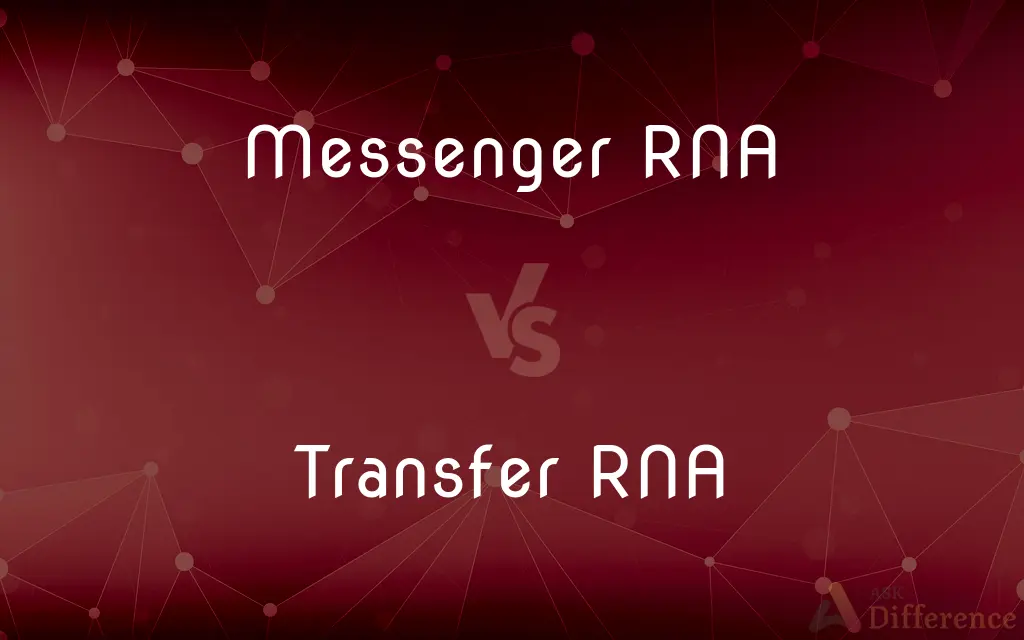Messenger RNA vs. Transfer RNA — What's the Difference?
Edited by Tayyaba Rehman — By Fiza Rafique — Published on June 20, 2024
Messenger RNA (mRNA) serves as a template for protein synthesis, while Transfer RNA (tRNA) brings amino acids to the ribosome during translation.

Difference Between Messenger RNA and Transfer RNA
Table of Contents
ADVERTISEMENT
Key Differences
Messenger RNA (mRNA) is synthesized from a DNA template during the process of transcription, carrying the genetic information needed for protein synthesis. Whereas transfer RNA (tRNA) functions as an adaptor molecule in translation, linking the mRNA codons to their respective amino acids to form a protein.
mRNA is a linear molecule that contains codons, sequences of three nucleotides that specify particular amino acids. On the other hand, tRNA has a cloverleaf structure with an anticodon loop that recognizes and pairs with the appropriate mRNA codon.
The role of mRNA is primarily in the nucleus and cytoplasm for eukaryotes, where it acts as a messenger between DNA and the ribosome. In contrast, tRNA operates mainly in the cytoplasm, specifically at the ribosome, where protein synthesis occurs.
mRNA molecules are variable in length, depending on the gene being transcribed, and are single-stranded. Whereas tRNA molecules are relatively small, about 76-90 nucleotides in length, and have a characteristic three-dimensional structure.
While mRNA is involved in carrying the genetic code for protein synthesis, tRNA's function is to interpret this code and provide the correct amino acids for polypeptide chain formation during translation.
ADVERTISEMENT
Comparison Chart
Function
Carries genetic code from DNA for protein synthesis
Brings amino acids to ribosome for protein assembly
Structure
Linear, single-stranded
Cloverleaf, L-shaped 3D structure
Location
Nucleus and cytoplasm (in eukaryotes)
Cytoplasm, at the ribosome
Length
Variable, depending on gene
Short, 76-90 nucleotides
Key Feature
Codons
Anticodon loop and amino acid attachment site
Compare with Definitions
Messenger RNA
A type of RNA that conveys genetic information from DNA to the ribosome, where proteins are synthesized.
During viral infections, the mRNA of the virus is used by the host cell's machinery to produce viral proteins.
Transfer RNA
TRNA molecules have a characteristic cloverleaf structure and an L-shaped 3D configuration.
The anticodon loop of tRNA is crucial for matching mRNA codons with the correct amino acid.
Messenger RNA
The length and sequence of mRNA molecules vary widely, reflecting the diversity of proteins they encode.
The mRNA for histone proteins is much shorter than that for dystrophin, the largest human protein.
Transfer RNA
TRNA translates the genetic code on mRNA into the amino acid sequence of proteins.
The tRNA for alanine recognizes the codon GCU on mRNA and adds an alanine to the growing polypeptide chain.
Messenger RNA
MRNA's primary role is in the process of translation, where its sequence determines the amino acid sequence of the synthesized protein.
Mutations in mRNA can lead to incorrect protein synthesis, potentially causing diseases.
Transfer RNA
A type of RNA that helps decode a messenger RNA (mRNA) sequence into a protein during the process of translation.
Each tRNA molecule carries a specific amino acid to the ribosome, corresponding to the codon it recognizes on the mRNA.
Messenger RNA
MRNA is synthesized from a DNA template during transcription.
In response to cellular signals, mRNA is synthesized to express specific genes needed for the cell's function.
Transfer RNA
The 3' end of tRNA is the site for amino acid attachment, making it ready for incorporation into the growing polypeptide chain.
Enzymes called aminoacyl-tRNA synthetases are responsible for attaching the correct amino acid to its corresponding tRNA.
Messenger RNA
MRNA contains codons, sequences of three nucleotides that correspond to specific amino acids or stop signals during translation.
The codon AUG on mRNA signals the start of protein synthesis and codes for the amino acid methionine.
Transfer RNA
The anticodon loop of tRNA contains a sequence of three bases complementary to the mRNA codon.
If the mRNA codon is AUG, the anticodon of the tRNA carrying methionine will be UAC.
Common Curiosities
What is the main function of mRNA and tRNA?
mRNA carries genetic information for protein synthesis, while tRNA brings amino acids to the ribosome for protein assembly.
How does tRNA recognize the correct codon on mRNA?
The anticodon loop of tRNA pairs with the complementary codon on mRNA.
How do the structures of mRNA and tRNA differ?
mRNA is linear and single-stranded, whereas tRNA has a cloverleaf structure and a complex 3D shape.
Where do mRNA and tRNA function within the cell?
mRNA functions both in the nucleus (in eukaryotes) and cytoplasm, while tRNA operates mainly in the cytoplasm at the ribosome.
What is the significance of codons in mRNA?
Codons in mRNA specify the amino acids to be added during protein synthesis.
What happens if there's a mutation in mRNA?
Mutations in mRNA can lead to incorrect protein synthesis, possibly resulting in diseases.
What role does the anticodon loop of tRNA play?
It ensures that tRNA brings the correct amino acid to the corresponding mRNA codon during translation.
What is the role of aminoacyl-tRNA synthetases?
They attach the correct amino acid to its corresponding tRNA.
How does the length of mRNA compare to tRNA?
mRNA length varies widely, reflecting the protein it encodes, while tRNA is relatively short and consistent in length.
Can mRNA and tRNA be found in all types of cells?
Yes, both are essential for protein synthesis in all living cells.
How does the structure of tRNA contribute to its function?
The 3D shape and anticodon loop of tRNA enable it to bring the correct amino acid to the ribosome.
Are there different types of tRNA for each amino acid?
Yes, there are specific tRNAs for each of the 20 amino acids.
How are mRNA and tRNA involved in gene expression?
mRNA transcribes genetic information from DNA, and tRNA translates this information into proteins.
Can the function of mRNA and tRNA be interchanged?
No, each has a unique and specific role in protein synthesis.
What is the significance of the 3' end of tRNA?
It is the site for amino acid attachment, crucial for protein synthesis.
Share Your Discovery

Previous Comparison
Conflict vs. Bullying
Next Comparison
State Senator vs. US SenatorAuthor Spotlight
Written by
Fiza RafiqueFiza Rafique is a skilled content writer at AskDifference.com, where she meticulously refines and enhances written pieces. Drawing from her vast editorial expertise, Fiza ensures clarity, accuracy, and precision in every article. Passionate about language, she continually seeks to elevate the quality of content for readers worldwide.
Edited by
Tayyaba RehmanTayyaba Rehman is a distinguished writer, currently serving as a primary contributor to askdifference.com. As a researcher in semantics and etymology, Tayyaba's passion for the complexity of languages and their distinctions has found a perfect home on the platform. Tayyaba delves into the intricacies of language, distinguishing between commonly confused words and phrases, thereby providing clarity for readers worldwide.














































